MITSUBISHI iMiEV 2015 (in English) User Guide
Manufacturer: MITSUBISHI, Model Year: 2015, Model line: iMiEV, Model: MITSUBISHI iMiEV 2015Pages: 262, PDF Size: 26.84 MB
Page 11 of 262
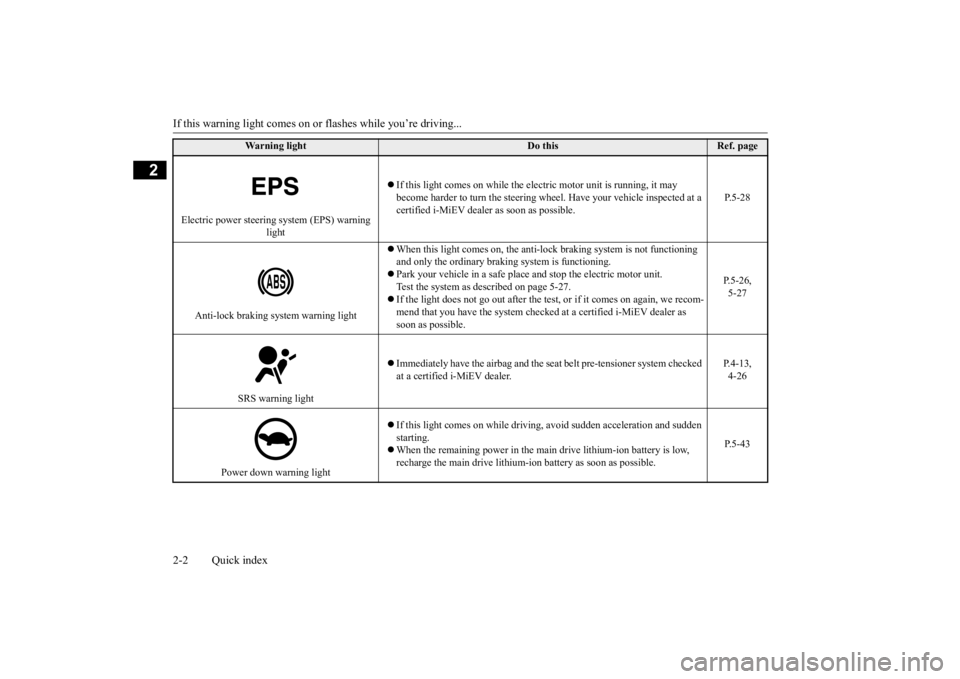
If this warning light comes on or flashes while you’re driving... 2-2 Quick index
2
Electric power steering
system (EPS) warning
light
If this light comes on while the elec
tric motor unit is running, it may
become harder to turn the steering wh
eel. Have your vehicle inspected at a
certified i-MiEV
dealer as soon as possible.
P. 5 - 2 8
Anti-lock braking system warning light
When this light comes on, the anti-l
ock braking system is not functioning
and only the ordinary brak
ing system is functioning.
Park your vehicle in a safe plac
e and stop the electric motor unit.
Test the system as described on page 5-27. If the light does not go out
after the test, or if it comes on again, we recom-
mend that you have the system checked
at a certified i-MiEV dealer as
soon as possible.
P.5-26, 5-27
SRS warning light
Immediately have the airb
ag and the seat belt pre-
tensioner system checked
at a certified i-MiEV dealer.
P.4-13, 4-26
Power down warning light
If this light comes on while driving,
avoid sudden acce
leration and sudden
starting. When the remaining power in the main drive lithium-ion battery is low, recharge the main drive lithium-ion battery as soon as possible.
P. 5 - 4 3
Warning light
Do this
Ref. page
BK0209800US.book 2 ページ 2014年1月14日 火曜日 午前9時26分
Page 12 of 262
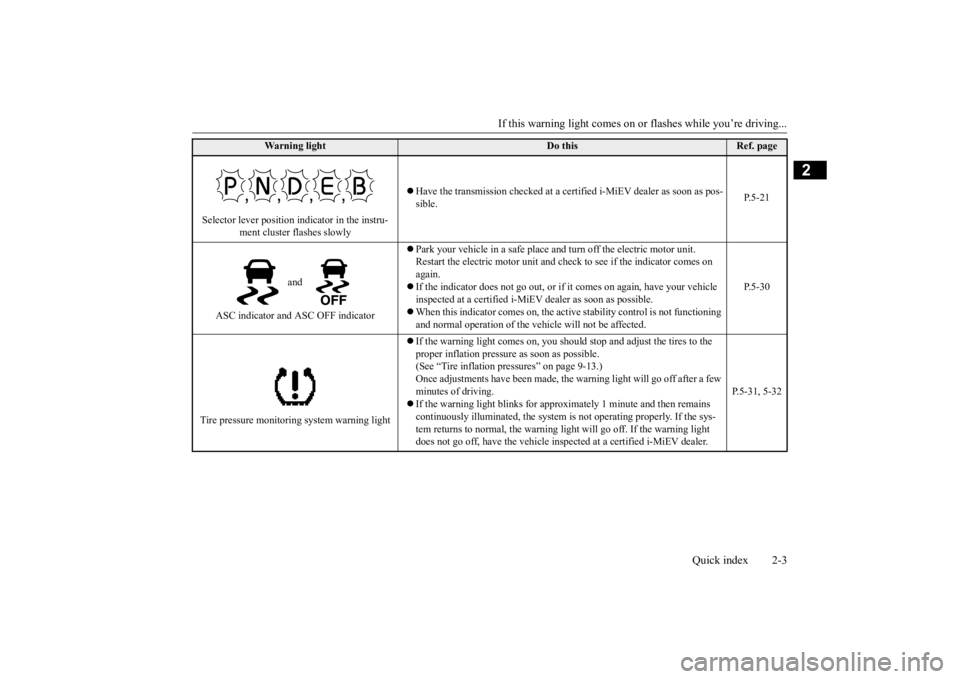
If this warning light comes on or
flashes while you’re driving...
Quick index 2-3
2
Selector lever position indicator in the instru-
ment cluster flashes slowly
Have the transmission checked at a cert
ified i-MiEV dealer as soon as pos-
sible.
P.5-21
and
ASC indicator and ASC OFF indicator
Park your vehicle in a safe place a
nd turn off the electric motor unit.
Restart the electric motor unit and check to see if the indicator comes on again. If the indicator does not go out, or if it
comes on again, have your vehicle
inspected at a certified i-MiEV
dealer as soon as possible.
When this indicator comes on, the acti
ve stability contro
l is not functioning
and normal operation of the vehi
cle will not be affected.
P.5-30
Tire pressure monitoring system warning light
If the warning light comes on, you shoul
d stop and adjust the tires to the
proper inflation pressure
as soon as possible.
(See “Tire inflation pr
essures” on page 9-13.)
Once adjustments have been made, the
warning light will go off after a few
minutes of driving. If the warning light blinks for appr
oximately 1 minute and then remains
continuously illuminated, the system is
not operating properly. If the sys-
tem returns to normal, the warning li
ght will go off. If the warning light
does not go off, have the vehicle insp
ected at a certified i-MiEV dealer.
P.5-31, 5-32
Warning light
Do this
Ref. page
BK0209800US.book 3 ページ 2014年1月14日 火曜日 午前9時26分
Page 13 of 262
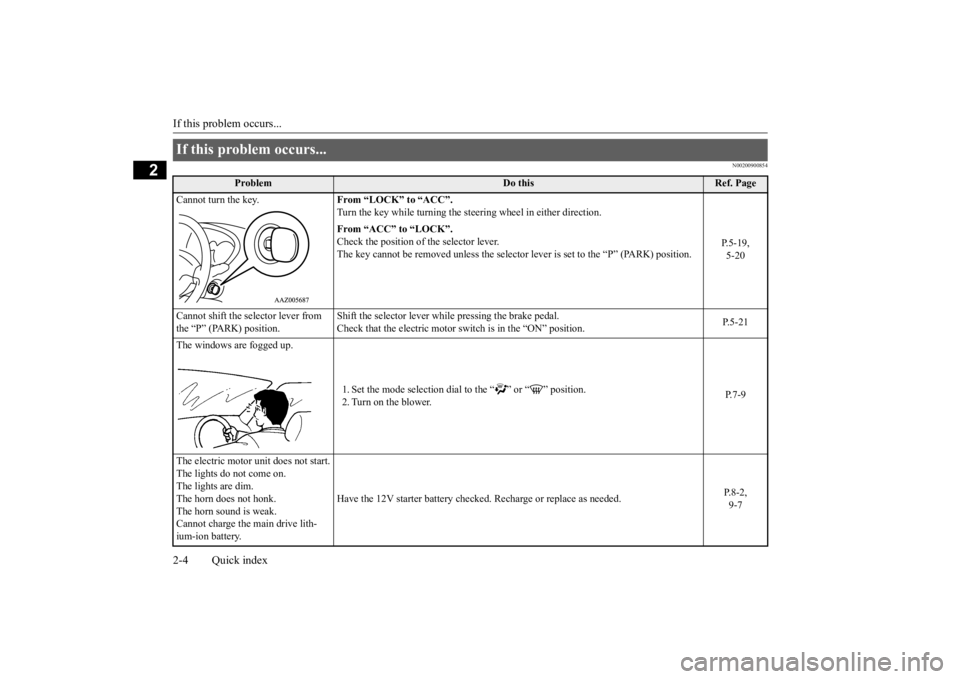
If this problem occurs... 2-4 Quick index
2
N00200900854
If this problem occurs...
Problem
Do this
Ref. Page
Cannot turn the key.
From “LOCK” to “ACC”. Turn the key while turning the st
eering wheel in either direction.
P.5-19, 5-20
From “ACC” to “LOCK”. Check the position of the selector lever. The key cannot be removed unless the selector
lever is set to the “P” (PARK) position.
Cannot shift the selector lever from the “P” (PARK) position.
Shift the selector lever wh
ile pressing the brake pedal.
Check that the electric motor switch is in the “ON” position.
P.5-21
The windows are fogged up.
1. Set the mode selection dial
to the “ ” or “ ” position.
2. Turn on the blower.
P.7-9
The electric motor unit does not start. The lights do not come on. The lights are dim. The horn does not honk. The horn sound is weak. Cannot charge the main drive lith-ium-ion battery.
Have the 12V starter battery checked.
Recharge or replace as needed.
P.8-2, 9-7
BK0209800US.book 4 ページ 2014年1月14日 火曜日 午前9時26分
Page 14 of 262
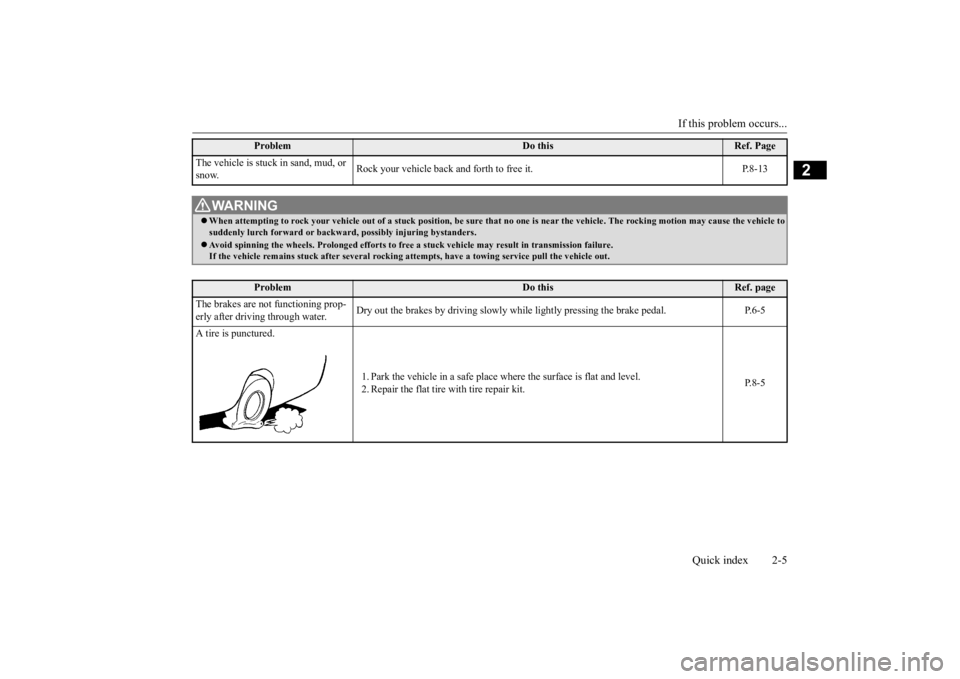
If this problem occurs...
Quick index 2-5
2
The vehicle is stuck
in sand, mud, or
snow.
Rock your vehicle back and forth to free it. P.8-13
WA R N I N G When attempting to rock your vehicle out of
a stuck position, be sure that
no one is near the vehicl
e. The rocking motion may c
ause the vehicle to
suddenly lurch forward or backward, possibly injuring bystanders. Avoid spinning the wheels. Prolonged efforts to free
a stuck vehicle may result
in transmission failure.
If the vehicle remains stuck after several rocking attempts, have a towing service pull the vehicle out.
Problem
Do this
Ref. page
The brakes are not functioning prop- erly after driving through water.
Dry out the brakes by driving slowly whil
e lightly pressing the brake pedal. P.6-5
A tire is punctured.
1. Park the vehicle in a safe place where the surface is flat and level. 2. Repair the flat tire with tire repair kit.
P.8-5
Problem
Do this
Ref. Page
BK0209800US.book 5 ページ 2014年1月14日 火曜日 午前9時26分
Page 15 of 262

BK0209800US.book 6 ページ 2014年1月14日 火曜日 午前9時26分
Page 16 of 262
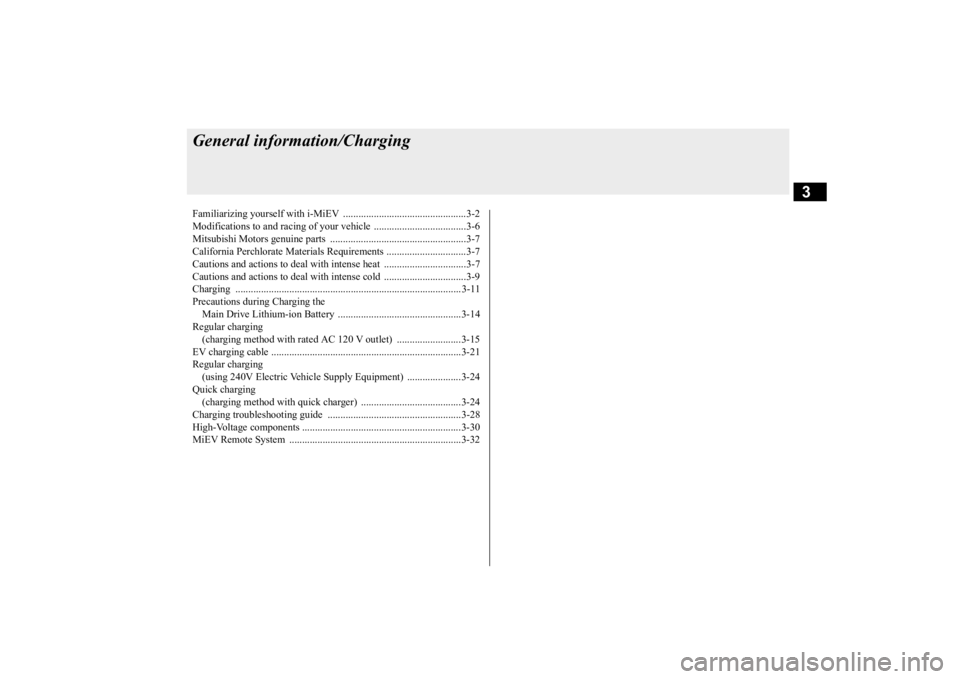
3
General information/ChargingFamiliarizing yourself with i-
MiEV ........
...........
...........
...........
.......3-2
Modifications to and racing of your vehi
cle ...........
...........
.........
.....3-6
Mitsubishi Motors genuine parts .....................................................3-7California Perchlorate Materials Requirements ...............................3-7 Cautions and actions to deal with intense heat ................................3-7 Cautions and actions to deal with intense cold ................................3-9Charging ........................................................................................ 3-11 Precautions during Charging the Main Drive Lithium-ion Battery ................................................3-14Regular charging (charging method with rated AC 120 V
outlet) .....
........
............3-15
EV charging cable ..........................................................................3-21Regular charging (using 240V Electric Vehi
cle Supply Equipment) ..
...................3-24
Quick charging (charging method with quick charger) ..
..............
.........
.........
.....3-24
Charging troubleshooting guide ....................................................3-28 High-Voltage components ......
...........
...........
...........
.........
.........
.....3-30
MiEV Remote System ...................................................................3-32
BK0209800US.book 1 ページ 2014年1月14日 火曜日 午前9時26分
Page 17 of 262
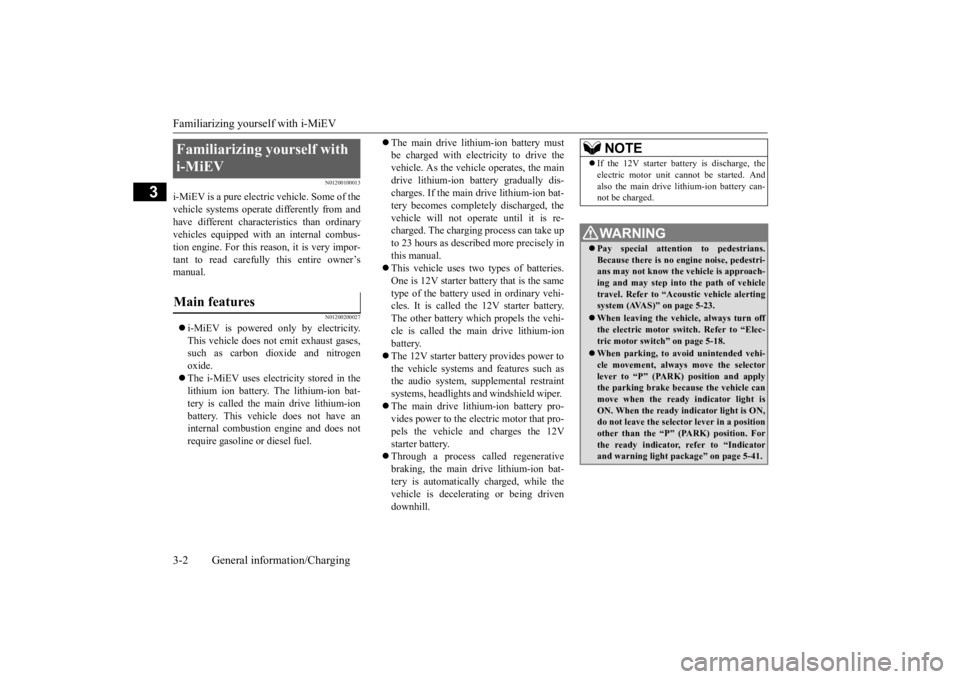
Familiarizing yourself with i-MiEV 3-2 General information/Charging
3
N01200100013
i-MiEV is a pure electric vehicle. Some of the vehicle systems operate differently from and have different characteristics than ordinaryvehicles equipped with an internal combus- tion engine. For this reas
on, it is very impor-
tant to read carefull
y this entire owner’s
manual.
N01200200027
i-MiEV is powered only by electricity. This vehicle does not
emit exhaust gases,
such as carbon dioxide and nitrogenoxide. The i-MiEV uses electricity stored in the lithium ion battery. The lithium-ion bat-tery is called the main drive lithium-ion battery. This vehicl
e does not have an
internal combustion engine and does notrequire gasoline
or diesel fuel.
The main drive lithium-ion battery must be charged with electricity to drive thevehicle. As the vehi
cle operates, the main
drive lithium-ion battery gradually dis- charges. If the main drive lithium-ion bat-tery becomes completely discharged, the vehicle will not
operate until it is re-
charged. The charging process can take upto 23 hours as descri
bed more precisely in
this manual. This vehicle uses two types of batteries. One is 12V starter battery that is the same type of the battery used in ordinary vehi-cles. It is called the 12V starter battery. The other battery which propels the vehi- cle is called the main drive lithium-ionbattery. The 12V starter battery provides power to the vehicle systems and features such asthe audio system, supplemental restraint systems, headlights a
nd windshield wiper.
The main drive lithium-ion battery pro- vides power to the electric motor that pro- pels the vehicle and charges the 12V starter battery. Through a process called regenerative braking, the main drive lithium-ion bat- tery is automatically charged, while thevehicle is decelera
ting or being driven
downhill.
Familiarizing yourself with i-MiEV Main features
NOTE
If the 12V starter batter
y is discharge, the
electric motor unit ca
nnot be started. And
also the main drive lithium-ion battery can-not be charged.WA R N I N G Pay special attention to pedestrians. Because there is no engine noise, pedestri- ans may not know the vehicle is approach-ing and may step into
the path of vehicle
travel. Refer to “Aco
ustic vehicle alerting
system (AVAS)” on page 5-23. When leaving the vehicl
e, always turn off
the electric motor switch. Refer to “Elec-tric motor switch” on page 5-18. When parking, to avoi
d unintended vehi-
cle movement, always move the selector lever to “P” (PARK)
position and apply
the parking brake because the vehicle canmove when the ready indicator light is ON. When the ready indicator light is ON, do not leave the select
or lever in a position
other than the “P” (PARK) position. For the ready indicator,
refer to “Indicator
and warning light pack
age” on page 5-41.
BK0209800US.book 2 ページ 2014年1月14日 火曜日 午前9時26分
Page 18 of 262

Familiarizing yourself with i-MiEV
General information/Charging 3-3
3
N01205601023
Motion energy is converted into electric energy using the motor as a power generator. While decelerating, electric energy will becreated and used to charge to the main drive lithium-ion battery. If you lift your foot off the accelerator pedal while driving, a braking force thatequivalent to the engine braking of a gas- oline or diesel powered vehicle engine vehicle will
be generate.
For increased regenerative braking, set the selector lever to “B” (REGENERATIVE BRAKE MODE) or “ECO” (ECOMODE) as follows: • “B”: Strong regenerative braking (For downhill driving)• “ECO”: Moderate regenerative braking (For economical driving or gentle down- hill driving)
As greater brake fo
rce is applied by
depressing the brak
e pedal, increased
regenerative braking occurs.
N01200300015
Keep the brake pedal depressed until you are ready to drive. When the vehicle is inthe “D” (DRIVE), “ECO” (ECO MODE),“B” (REGENERATIVE BRAKE MODE) or “R” (REVERSE) position, if you release the brake pedal and even if you donot depress accelerator, the vehicle will creep and may move slowly.
Regenerative braking
WA R N I N G
NOTE
When the main drive lithium-ion battery level is full or nearly
full, or the main drive
lithium-ion battery temperature is too high or too low, the regenerative braking force may be reduced and stronger service brake effortmay be required to operate the brakes. When the main drive lithium-ion battery level is no longer full or near full,
or the main drive lith-
ium-ion battery temperature has returned to a normal range, the regene
rative brake force
will resume. If a problem occurs in the electric motor unit, or if the ABS and/or the ASC have been acti-vated, the regenerati
ve braking will be
restricted. The service brakes will still oper- ate.
Main drive lithium-ion battery
WA R N I N G The main drive lithium-ion battery is a sealed high voltage battery and has nouser serviceable parts.
• To avoid severe burn
s and/or
electrical
shock that may result in serious injury ordeath, never attempt to detach the maindrive lithium-ion battery from the vehi- cle or try to disassemble it.• Never attempt to dispose or recycle themain drive lithium-ion battery by your- self. Consult with a certified i-MiEVdealer, when the main drive lithium-ion battery is disposed or recycled.• Never attempt to use the main drive lith-ium-ion battery for any other purpose.CAUTION To help prevent damage to the main drive lithium-ion battery, foll
ow the instructions
described below. Failure
to do so can result
in damage to the main
drive lithium-ion bat-
tery that will not
be covered by the main
drive lithium-ion battery warranty.• Do not leave your vehicle with the energylevel gauge (Refer to
“Energy level gauge”
on page 5-40) showing 0 bars.• Repeatedly performing quick charging canreduce battery capacity. Regular charging isrecommended unless quic
k charging is nec-
essary.WA R N I N G
BK0209800US.book 3 ページ 2014年1月14日 火曜日 午前9時26分
Page 19 of 262
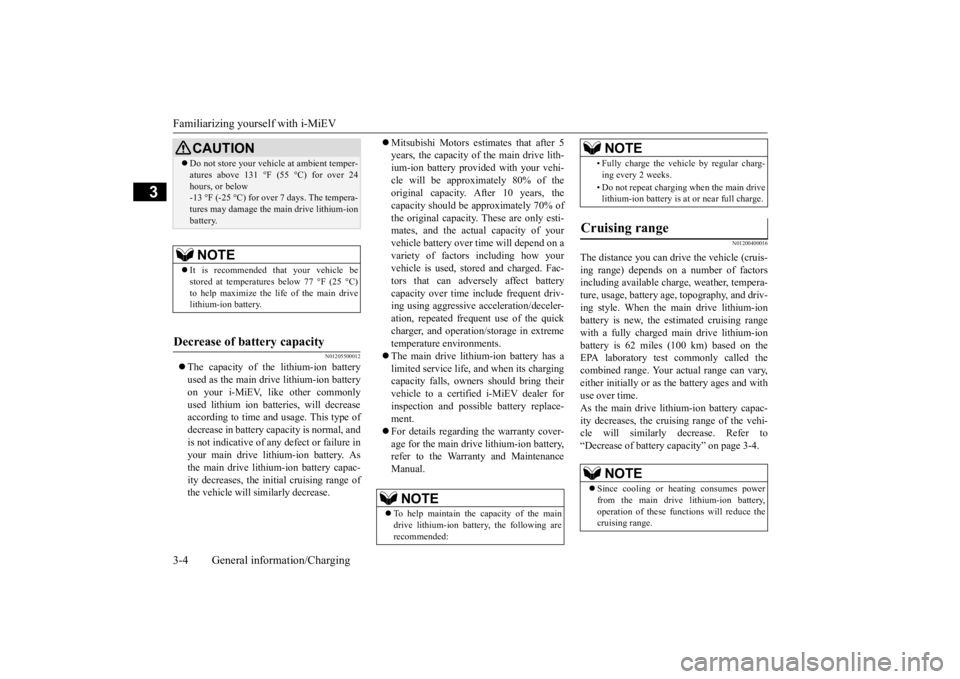
Familiarizing yourself with i-MiEV 3-4 General information/Charging
3
N01205500012
The capacity of the lithium-ion battery used as the main drive lithium-ion battery on your i-MiEV, like other commonly used lithium ion batt
eries, will decrease
according to time and usage. This type of decrease in battery capacity is normal, and is not indicative of a
ny defect or failure in
your main drive lithium-ion battery. As the main drive lithium-ion battery capac- ity decreases, the in
itial cruising range of
the vehicle will si
milarly decrease.
Mitsubishi Motors estimates that after 5 years, the capacity of the main drive lith-ium-ion battery provided with your vehi- cle will be a
pproximately 80% of the
original capacity. Af
ter 10 years, the
capacity should be approximately 70% of the original capacity. These are only esti- mates, and the actual capacity of yourvehicle battery over
time will depend on a
variety of factors including how your vehicle is used, stored and charged. Fac- tors that can adve
rsely affect battery
capacity over time incl
ude frequent driv-
ing using aggressive
acceleration/deceler-
ation, repeated frequent use of the quick charger, and operation/storage in extremetemperature environments. The main drive lithium-ion battery has a limited service life, and when its chargingcapacity falls, owne
rs should bring their
vehicle to a certified i-MiEV dealer for inspection and possible battery replace-ment. For details regardi
ng the warranty cover-
age for the main drive lithium-ion battery,refer to the Warranty and Maintenance Manual.
N01200400016
The distance you can driv
e the vehicle (cruis-
ing range) depends on
a number of factors
including available char
ge, weather, tempera-
ture, usage, battery age, topography, and driv- ing style. When the main drive lithium-ion battery is new, the estimated cruising rangewith a fully charged main drive lithium-ion battery is 62 miles (100 km) based on the EPA laboratory test commonly called thecombined range. Your actual range can vary, either initially or as the battery ages and with use over time.As the main drive lithium-ion battery capac- ity decreases, the cruising range of the vehi- cle will similarly decrease. Refer to“Decrease of battery capacity” on page 3-4.
Do not store your vehicle at ambient temper- atures above 131 °F (55 °C) for over 24hours, or below -13 °F (-25 °C) for over 7 days. The tempera- tures may damage the
main drive lithium-ion
battery.NOTE
It is recommended that your vehicle be stored at temperatures below 77 °F (25 °C)to help maximize the life of the main drive lithium-ion battery.
Decrease of battery capacity
CAUTION
NOTE
To help maintain the capacity of the main drive lithium-ion batter
y, the following are
recommended:
• Fully charge the vehicle by regular charg-ing every 2 weeks. • Do not repeat charging when the main drive lithium-ion battery is at
or near full charge.
Cruising range
NOTE
Since cooling or he
ating consumes power
from the main drive lithium-ion battery,operation of these functions will reduce the cruising range.NOTE
BK0209800US.book 4 ページ 2014年1月14日 火曜日 午前9時26分
Page 20 of 262
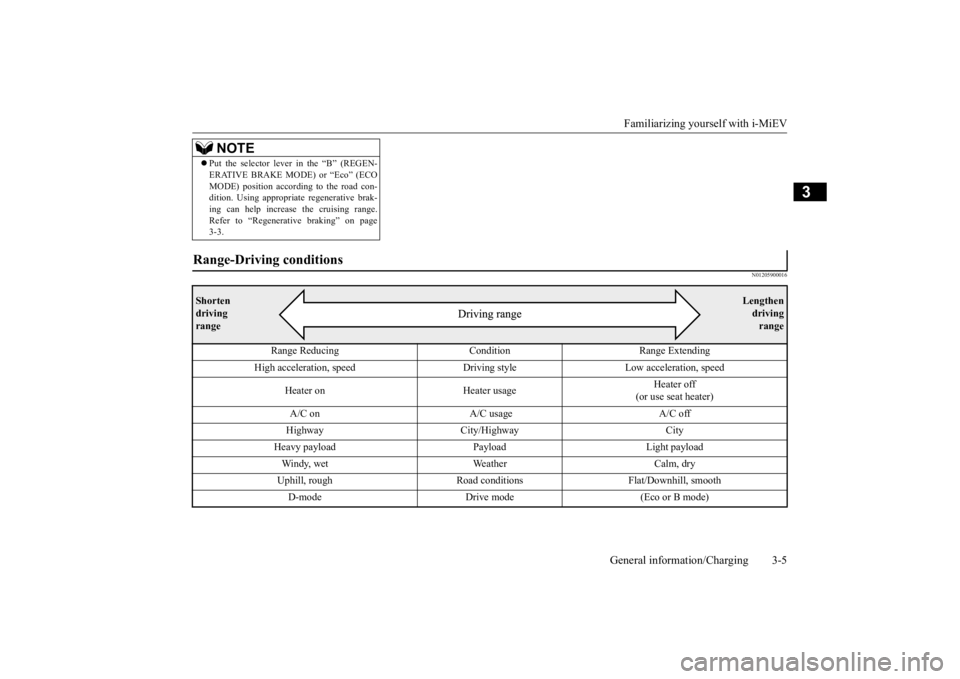
Familiarizing yourself with i-MiEV
General information/Charging 3-5
3
N01205900016
Put the selector lever in the “B” (REGEN- ERATIVE BRAKE MODE) or “Eco” (ECOMODE) position according to the road con-dition. Using appropriate regenerative brak- ing can help increase
the cruising range.
Refer to “Regenerative braking” on page3-3.NOTE
Range-Driving conditions Shorten driving range
Lengthen
driving range
Range Reducing Condition Range Extending
High acceleration, speed Driving
style Low acceleration, speed
Heater on Heater usage
Heater off
(or use seat heater)
A/C on A/C usage A/C off Highway City/Highway City
Heavy payload Payload Light payload Windy, wet Weather Calm, dry Uphill, rough Road conditio
ns Flat/Downhill, smooth
D-mode Drive mode (Eco or B mode)
BK0209800US.book 5 ページ 2014年1月14日 火曜日 午前9時26分